Nawabs of Bengal and Murshidabad
| Nawab Nizam of Bengal, Bihar and Orissa (1717–1880)a and Nawab Bahadur of Murshidabad (1882–1950)b | ||||||||||
| Nawabs of Bengal and Murshidabad | ||||||||||
| ||||||||||
|
| ||||||||||
| Motto Nil Desparandum "There is no cause for despair, never despair" | ||||||||||
 The Nawab Nizams of Bengal, Bihar and Orissa ruled over the Bengal Subah and were subordinate to the Mughal empire, however after the Battle of Plassey in 1757, and acquisition of the administration of the subah from the then Mughal Emperor, Shah Alam II, by the British East India Company, the Bengal Presidency was established, which included the Bengal subah and surther, the system of dual government was established in 1772. Thus, the Nawabs became "puppet rulers" of the British, with very little real power and authority to exercise and lost even that little power when the Nizamat (power to exercise military power and criminal justice) of the Nawab was also taken away from them; the Nawabs remained as the mere pensioners of the British East India Company. After the Revolt of 1857, the regions under the Company rule came under the British Crown, and by now, the post/office of the Nawabs was just titular. They had no real power and authority. Further, after Indian independence, in 1947, the region first came under the rule of the Dominion of Pakistan for two days, and then the Dominion of India, followed by the Republic of India in 1950, and since then has remained under the rule of the republic. Shown here is a 1776 map of the Bengal Presidency, after it came under Company rule and prior to its takeover by the British Crown and the partition of Bengal. | ||||||||||
| Capital | Murshidabadc | |||||||||
| Languages | English | |||||||||
| Government | Nobility | |||||||||
| Historical era | Mughal rule in India Company rule in India | |||||||||
| • | Emergence of the Mughal Empire | 1526 | ||||||||
| • | Established | 1717 | ||||||||
| • | Battle of Plassey | 23 June 1757 | ||||||||
| • | Battle of Buxar | 22 October 1764 | ||||||||
| • | Abolition of the title of Nawab of Bengal | 1880 | ||||||||
| • | Abdication of Mansoor Ali Khan, the last Nawab of Bengal | 1 November 1880 | ||||||||
| • | Emergence of the Nawab of Murshidabad | 17 February 1882 | ||||||||
| • | Disestablished | 1765 | ||||||||
| Population | ||||||||||
| • | 1901 est. | 75 million[1] | ||||||||
| ||||||||||
| Today part of | | |||||||||
| a. | Title abolished in 1880 | |||||||||
| b. | After Indian independence in 1947, followed by the promulgation of the Indian Constitution on 26 January 1950, which marked the transformation of the Dominion of India into the Republic of India, the Article 18 of the Indian Constitution abolished all titles, except those given by the Government of India to those who have made their mark in military and academic fields. Thus the title of the "Nawab Bahadur of Murshidabad" was officially, constitutionally and legally abolished. | |||||||||
| c. | Murshidabad was the capital for both the Nawabs of Bengal and the Nawabs of Murshidabad. | |||||||||
Part of a series on the |
|---|
| History of Bangladesh |
.jpg) |
|
Ancient
|
|
Classical
|
|
Medieval
|
|
Modern
|
|
Related articles |
The Nawabs of Bengal (full title, the Nawab Nizam of Bengal, Bihar and Orissa) were the rulers of the then provinces of Bengal, Bihar and Orissa. Between 1717 and 1765, they served as the rulers of the subah (or province) of Bengal. However, they were subordinate to the Mughal Empire. Siraj ud-Daulah, the last independent Nawab of Bengal was betrayed in the Battle of Plassey by Mir Jafar. He lost to the British, who took over the charge of Bengal in 1757, installed Mir Jafar on the Masnad (throne) and established itself to a political power in Bengal.[2]
In 1765 the system of Dual Government was established, in which the Nawabs ruled on behalf of the British and were mere puppets to the British. In 1772 the system was abolished and Bengal was brought under direct control of the British. In 1793, when the Nizamat (governorship) of the Nawab was also taken away from them, they remained as the mere pensioners of the British East India Company.[3][4] The last Nawab of Bengal, Mansur Ali Khan abdicated on 1 November 1880 in favour of his eldest son, Hassan Ali Mirza.[5]
Nawabs of Murshidabad succeeded the Nawabs of Bengal as Nawab Bahadur of Murshidabad, following Mansur Ali Khan's abdication[5][6] They got the title changed as the title of the Nawab of Bengal was abolished in 1880. They had little or no say in the share of the revenue collected and were ceased to use any force. After Indian Independence in 1947 it was declared that the princely states must accede to either India or Pakistan (East/West Pakistan).[7] Murshidabad (the capital city) became a part of East Pakistan (now Bangladesh) for two days, as it had a Muslim majority. It became a part of India on 17 August 1947, following which the Pakistani flag was brought down from the Hazarduari Palace and the Indian tricolour was hoisted atop it. After merging with India, they had no power as the Government of India took over all the princely states in India.[7] The house of the Nawabs appeared to have come to end in 1969 with Waris Ali Mirza being the last reigning Nawab and with no clear succession.[8] Although he left three sons and three daughters there was no clear successor to the title after his death because he disinherited one and the others disputed his will.[8]
Eventually, in August 2014, the Supreme Court of India declared Syed Mohammed Abbas Ali Mirza (born 1942)[9] to be the present Nawab Bahadur of Murshidabad and lawful heir to the royal title which had been in abeyance since the death of his maternal uncle Waris Ali Mirza (the third Nawab Bahadur of Murshidabad) in 1969.[9]
Bengal
The term "Bengal" incorporates to delineate the ethno-linguistic region of Bengal which including but not limited is all districts within the People's Republic of Bangladesh, as well as West Bengal, India.[10][11][12] During the first partition of Bengal in the early 20th century a new province, Eastern Bengal was created as a Lieutenant-Governorship along with Assam.[13] In 1911, East Bengal (now Bangladesh) was reunited with Bengal, and the new provinces in the east became: Assam, Bengal Province, Bihar and Orissa.[14] The Nawab thus gained rule over Bihar and Orissa, which were earlier part of Bengal.[15][16][17] So sometimes That is why the Nawabs of Bengal were also mentioned as "Nawab of Bengal, Bihar and Orissa" or "Nawab Nazim of Bengal, Bihar and Orissa"[18] - where Nazim (or, Subahdar) means the provincial governor - as they ruled over three subahs while the Nawabs of Murshidabad were the local ruler of the city of Murshidabad.[19] The majority of modern Bengal is inhabited by Bengali people who speak the Bengali language.[20]
-
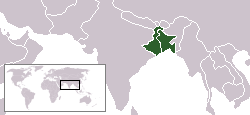
Modern Bengal include the present day country of Bangladesh and the present day Indian states of West Bengal and Tripura
-
1893 map of Bengal
-
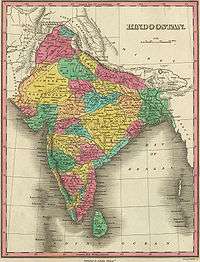
1831 map of Hindustan showing the then Bengal in green in the north east
History before the Nawab's rule
Sultans of Bengal
The early Sultans of Bengal ruled until 1282 which was followed by the rule of several successive dynasties. Ilyas Shah founder of the Ilyas Shahi dynasty, took complete charge of the then Bengal[21] and the capital was shifted to Sonargaon (near present day, Dhaka in Bangladesh).[22] He was one of the independent rulers of Bengal. His son, Sikandar Shah, who succeeded him, built the Adina Mosque at Pandua, near Gour, Adina Mosque in the medieval times, was considered to be the largest in undivided Bengal, as well as the entire Indian subcontinent.[23]
Mughal Empire
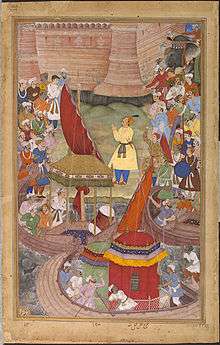
The Mughal Empire emerged as a powerful Empire in northern India. Babur, who was related to two legendary warriors – Timur and Genghis Khan, invaded north India and defeated Ibrahim Lodi of the Lodi dynasty.[24] Babur thus became the first Mughal emperor. He was succeeded by his son, Humayun. At the same time, Sher Shah Suri (alias Farid Khan) of the Suri dynasty rose to prominence and established himself as the ruler of the present day Bihar by defeating Ghiyasuddin Shah. But he lost to capture the kingdom because of sudden expedition of Humayun. In 1539, Sher Khan faced Humayun in the Battle of Chausa. He forced Humayun out of India. Assuming the title Sher Shah, he ascended the throne of Delhi. He also captured Agra and established control from Bengal in the east until the Indus River in the west.[25] After his death he was succeeded by his son, Islam Shah Suri. But in 1544 the Suris were torn apart by internal conflicts. Humayun took this advantage and captured Lahore and Delhi, but he died in 1556 AD.[26] He was succeeded by Akbar, who defeated Daud Khan Karrani of Bengal's Karrani Dynasty (or, Karnani Dynasty). After this, the administration of the entire region of Bengal passed into the hands of governors appointed by the Mughal emperors, who ruled Bengal till 1716 AD.[27][28][29]
There were several posts under the Mughal administrative system during Akbar's reign. Diwani was a system of provincial revenue administration under the Mughals. Nizamat (civil administration) and Diwani (revenue administration) were the two main branches of the provincial administration under the Mughals.[27] A Subahdar (provincial viceroy or governor), also called a Nizam was in-charge of the Nizamat. There was a chain of subordinate officials under the Nizams on the executive side and under Diwans on the revenue and judicial side.[27]
Emergence of the Nawab Nizam of Bengal
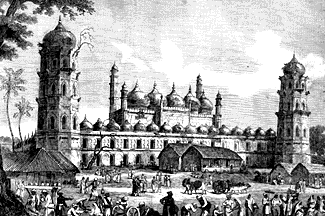
Murshid Quli Khan arrived as the Diwan of Bengal in 1717 AD. Before his arrival, there were four Diwans. And, after his arrival, Azim-ush-Shan held the Nizam's office. Azim got into conflict with Murshid Quli Khan over imperial financial control. Considering the complaint of Khan, the then Mughal emperor, Aurangzeb ordered Azim to move to Bihar.[30] Upon his departure the two posts united in one and Murshid Quli Khan became the first Nizam cum Diwan of Bengal. Murshid Khan was appointed the "Nawab Nizam of Bengal" and he emerged as the ruler of Bengal under the Mughals.[27][31] Murshidabad remained the capital of the Nawabs of Bengal until their rule.[27][32] The Nawab Siraj ud-Daulah, was betrayed in the Battle of Plassey by Mir Jaffer.[33] He lost to the British East India Company, who took installed Mir Jaffer on the Masnad (throne), as a "puppet ruler" and established itself to a political power in Bengal.[34]
In 1765, Robert Clive, of the British East India Company, became the first British Governor of Bengal.[35] He secured in perpetuity for the Company the Diwani (revenue and civil justice) of the then Bengal subah from the then Mughal Emperor, Shah Alam II and thus the system of Dual Government was established and the Bengal Presidency was formed. In 1772 the Dual Government system was abolished and Bengal was brought under direct control of the British. In 1793, when the Nizamat (military power and criminal justice) of the Nawab was also taken away from them, they remained as the mere pensioners of the British East India Company. After the Revolt of 1857, Company rule in India ended and the British Crown took over the territories which were under the direct rule of the British East India Company in 1858, which marked the beginning of the British Raj. These territories, including the territory of the Nawab Nazims came under the direct rule of the British Crown and British Raj was established in India. Thus, the Nawab Nizams remained just the titular heads of their territory, which was now ruled by the British Crown, and they had no political or any other kind of control over the territory.[36][37] The last Nawab of Bengal, Mansoor Ali Khan abdicated on 1 November 1880 in favour of his eldest son.[38]
History during the Nawab's rule
Part of a series on the |
|---|
| History of Bengal |
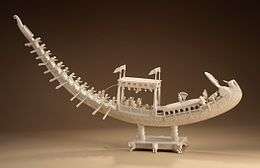 |
| Ancient geopolitical units |
| Ancient and classical dynasties |
| Medieval and Early Modern periods |
| European colonisation |
| Bangladesh |
| Indian Bengal |
| Related |
Dynasties
_being_a_synopsis_of_the_history_of_Murshidabad_for_the_last_two_centuries%2C_to_which_are_appended_notes_of_places_and_objects_of_interest_at_Murshidabad_(1905)_(14776529292).jpg)
From 1717 until 1880, three successive Islamic dynasties – Nasiri, Afshar and Najafi – ruled what was then known as Bengal.[39]
The first dynasty, the Nasiri, ruled from 1717 until 1740. The founder of the Nasiri, Murshid Quli Khan, was born a poor Deccani Odia Brahmin before being sold into slavery and bought by one Haji Shafi Isfahani, a Persian merchant from Isfahan who converted him to Islam. He entered the service of Mughal Emperor Aurangzeb and rose through the ranks before becoming the Nawab Nizam of Bengal in 1717, a post he held until his death in 1727. He in turn was succeeded by his son-in-law, Shuja-ud-Din Muhammad Khan.[40] After Shuja-ud-Din's death in 1739 he was succeeded by his son, Sarfaraz Khan, who held the rank, until he was killed in the Battle of Giria in 1741, and was succeeded by Alivardi Khan, former ruler of Patna, of the Afshar Dynasty in 1740.[41]
The second dynasty, the Afshar, ruled from 1740 to 1757. Siraj ud-Daulah (Alivardi Khan's grandson), the last Afshar Nawab was killed in the Battle of Plassey in 1757.[42] They were succeeded by the third and final dynasty to rule the whole Bengal, the Najafi.[43]
Under the Mughals
Bengal Subah was one of the wealthiest parts of the Mughal empire.[44] As the Mughal empire began to decline, the Nawabs grew in power, although nominally subordinate to the Mughal emperor.[27][45] They wielded great power in their own right and finally became independent rulers of the Bengal region, for all practical purposes, by the early 1700s.[45]
Maratha expeditions

Marathas undertook six expeditions in Bengal from 1741–1748. Maratha general, Raghunath Rao was able to annex Orissa to his kingdom and the larger confederacy permanently as he successfully exploited the chaotic conditions prevailing in Bengal, Bihar and Orissa after the death of Murshid Quli Khan in 1727.[46] Constantly harassed by the Bhonsles, Orissa, Bengal and parts of Bihar were economically ruined. Alivardi Khan made peace with Raghunathrao in 1751 ceding in perpetuity Orissa up to the river Suvarnarekha, and agreeing to pay ₹12 lacs annually in lieu of the Chauth of Bengal and Bihar.[47]
The treaty included ₹20 lacs as Chauth for Bengal (includes both West Bengal and Bangladesh) and ₹12 lacs for Bihar(including Jharkhand). After this, Maratha promised never to cross the boundary of the Nawab of Bengal's territory.[48]
Thus, Baji Rao is hailed as the greatest Maratha chief after Shivaji because of his success in subjecting Muslim rulers of east India in states such as Bengal, Bihar and Orissa to the Maratha rule.[49]
Nawabs of Bengal under British rule and their decline

The break-up of the centralised Mughal empire by 1750, led to the creation of numerous semi-independent kingdoms (all provinces of the former Mughal empire). Nawab Siraj ud-Daulah was defeated by the British forces of Sir Robert Clive in the Battle of Plassey in 1757.[42] Thereafter the Nawab of Bengal became a "puppet ruler" depending on military support from British East India company to secure their throne.[42] Siraj-ud-Daulah was replaced by Mir Jaffer. He was personally led to the throne by Robert Clive, after triumph of the British in the battle.[42] He briefly tried to re-assert his power by allying with the Dutch, but this plan was ended by the Battle of Chinsurah. After the defeat at Battle of Buxar and grant of the Diwani (revenue collection) of Bengal by the then Mughal Emperor Shah Alam II, to the British East India Company in August 1765 and the appointment of Warren Hastings by the East India Company as their first Governor General of Bengal in 1773, the Nawabs authority became restricted. By 1773, British East India company asserted much authority and formed the Bengal Presidency over areas ruled by the Nawabs i.e. the Bengal subah, along with some other regions and abolished the system of Dual Government. In 1793 (during Nawab Mubarak ud-Daulah's reign), the Nizamat (military power,civil and criminal justice) was abolished, British East India company thus annexed this former Mughal province as part of their empire and took complete control of the region, and the Nawabs of Bengal became mere pensioners of the British East India Company. All the Diwan offices except the Diwan Ton were also abolished.[36][37][50]
After the Revolt of 1857, Company rule in India ended, and all the territories which were under the rule of the British East India Company came under the British Crown in 1858, which marked the beginning of the British Raj. And administrative control of India came under the Indian Civil Service, which had administrative control over all areas in India, except the Princely States.[14]
Mansoor Ali Khan (aka Feradun Jah) was the last Nawab of Bengal. During his reign the Nizamat at Murshidabad became involved in debts. The then Government of India involved it into an action of preventing further claims. Feradun Jah left Murshidabad in February 1869 and started living in England. The title of "Nawab of Bengal" was abolished in 1880.[51] He returned to Bombay in October 1880 but spent most of his time pleading his case against the orders of the Government of India. After it was not resolved the Nawab renounced his styles and titles of Nawab Nizam of Bengal, Bihar and Orissa and abdicated in favour of his eldest son at St. Ives, Maidenhead, on 1 November 1880.[51]
Emergence of the Nawab of Murshidabad and the Nawabs post Indian independence
The Nawabs of Murshidabad succeeded the Nawab Nizams of Bengal, Bihar and Orissa as Nawab Bahadur of Murshidabad, following Mansoor Ali Khan's abdication[27][38][52] Nawabs of Murshidabad were the successors of the Nawabs of Bengal. After Lord Clive secured the Diwani of Bengal from Mughal Emperor Shah Alam II in 1765 for the East India Company they did not have any effective authority. So they lavishly enjoyed their title, privileges alongside with the honours they received. They got the title changed as the title of the Nawab of Bengal was abolished in 1880.[27] They had little or no say and ceased to control any significant force.[27][53]
After Indian Independence in 1947, all the non-princely states were subject to a test of religious majority in which the Muslim majority areas formed the Dominion of Pakistan, while the other regions formed the Dominion of India.[7] Murshidabad (the capital city for both, the Nawabs of Bengal and the Nawabs of Murshidabad) became a part of East Pakistan (now Bangladesh) for two days, as it had a Muslim majority. However, it became a part of India on 17 August 1947.[54] The Pakistani flag was brought down from the Hazarduari Palace and the Indian tricolour was hoisted atop the palace.[55] The Nawabs, after the takeover by the British had no actual power and after merging with India too, they had yielded power, as the Government of India took over control of all the areas that merged with India. Furthermore, with the promulgation of the Indian Constitution on 26 January 1950, the Dominion of India was transformed into the Republic of India, and the Article 18 of the Indian Constitution (which is a part of the Right to Equality, a fundamental right in India), titles were abolished. The Article prevents the state from confirming any title except those titles given by the Government to those who have made their mark in military and academic fields. Such titles and awards include the Bharat Ratna, the Padma Shri and the Padma Vibhushan (the Supreme Court of India, on 15 December 1995, upheld the validity of such awards). Thus, with the promulgation of the Constitution, the title of the Nawab Bahadur of Murshidabad was abolished. And although, the Nawab Waris Ali Meerza held titles such as Raes ud-Daulah, they were not officially or legally recognised.[7][56]
Although, the Nawab Bahadur of Murshidabad had no political power the office continued to be held by the second Nawab Bahadur Syed Wasif Ali Meerza Khan Bahadur, who had held the office since 1906, and after his death in 1959, he was succeeded by his son, Syed Wasif Ali Meerza Khan Bahadur.[7] Waris Ali Meerza died in 1969,[9] survived by his three sons and three daughters. According to the Nawab’s law, the eldest son of the Nawab succeeded him, however, Waris Ali's eldest son, Wakif Ali Meerza Bahadur, was excluded from the succession by his father for contracting a non-Muslim marriage and for not professing the Muslim religion.
Waris Ali Meerza, the third Nawab Bahadur of Murshidabad, died in 1969, and he took no steps during his lifetime to establish his succession. And before declaring his successor Waris Ali died. There was no clear successor to Waris Ali.[57]
Since then there was no clear successor to Waris Ali and the titular office/post was in dispute, and a legal battle ensued. And following this as the title was in dispute, a legal battle ensued. Abbas Ali Meerza claimed to be the legal heir of Waris Ali on the basis of being the son of the daughter of Waris Alis' father, the second Nawab Bahadur of Murshidabad, Wasif Ali Meerza; while Sajid Ali Meerza claimed the same on the basis of being the son by mut‘ah marriage of Wasif Ali. The case reached the Supreme Court and finally, the Supreme Court judges, Justice Ranjan Gogoi and Justice R K Agrawal, gave their judgement on 13 August 2014, declaring the then 72-year-old Abbas Ali Meerza (full name, Syed Mohammed Abbas Ali Meerza), who happened to be the son of the only daughter of Waris Ali’s father, Wasif Ali Meerza (the third Nawab Bahadur of Murshidabad), the successor and the legal heir to the former Nawab of Murshidabad, Waris Ali Meerza. The Court directed Abbas Ali Meerza, son of Syed Muhammad Sadeque Ali Meerza, to be the direct descendant of Waris Ali Meerza. However, the case against the state's annexation of the Murshidabad Estate, which is worth several thousand crores, is still on, as of 2014.[9][58]
However, as titles have been abolished in India, the title of the Nawab Bahadur of Murshidabad no longer exists. However, Abbas Ali Meerza can now legally succeed Waris Ali Meerza's office legally, but his title of the fourth Nawab Bahadur of Murshidabad would be unofficial,as the title is not legally and officially recognised.[9][58][59]
List of the Nawabs of Bengal
The following is a list of all the Nawabs of Bengal. Sarfaraz Khan and Mir Mohammad Jaffer Ali Khan (Mir Jaffer) were the only Nawabs to become the Nawab twice.[60] The chronology started in 1717 with Murshid Quli Khan and ended in 1881 with Mansoor Ali Khan's abdication.[27][38][60]
| Portrait | Titular Name | Personal Name | Birth | Reign | Death |
|---|---|---|---|---|---|
| Nasiri Dynasty | |||||
 |
Jaafar Khan Bahadur Nasiri | Murshid Quli Khan | 1665 | 1717–1727 | 1727[61][62][63] |
 |
Ala-ud-Din Haidar Jang | Sarfaraz Khan Bahadur | ? | 1727-1727 | 29 April 1740[64] |
 |
Shuja ud-Daula | Shuja-ud-Din Muhammad Khan | Around 1670 (date not available) | July 1727 – 26 August 1739 | 26 August 1739[65][66] |
 |
Ala-ud-Din Haidar Jang | Sarfaraz Khan Bahadur | ? | 13 March 1739 – April 1740 | 29 April 1740[64] |
| Afshar Dynasty | |||||
 |
Hashim ud-Daula | Muhammad Alivardi Khan Bahadur | Before 10 May 1671 | 29 April 1740 – 9 April 1756 | 9 April 1756[67][68] |
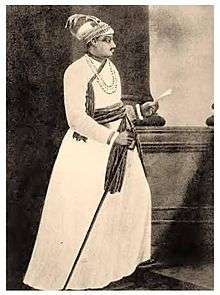 |
Siraj ud-Daulah | Muhammad Siraj-ud-Daulah | 1733 | April 1756 – 2 June 1757 | 2 July 1757[69][70] |
| Najafi Dynasty | |||||
_and_Mir_Miran_(right).jpg) |
Ja'afar 'Ali Khan Bahadur | Mir Mohammad Jaffer Ali Khan Bahadur | 1691 | June 1757 – October 1760 | 17 January 1765[71][72][73] |
 |
Itimad ud-Daulah | Mir Qasim Ali Khan Bahadur | ? | 20 October 1760 – 1763 | 8 May 1777[74] |
_and_Mir_Miran_(right).jpg) |
Ja'afar 'Ali Khan Bahadur | Mir Mohammad Jaffer Ali Khan Bahadur | 1691 | 25 July 1763 – 17 January 1765 | 17 January 1765[74][75] |
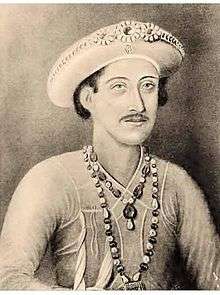 |
Nazam-ud-Daulah | Najimuddin Ali Khan Bahadur | 1750 | 5 February 1765 – 8 May 1766 | 8 May 1766[76] |
 |
Saif ud-Daulah | Najabut Ali Khan Bahadur | 1749 | 22 May 1766 – 10 March 1770 | 10 March 1770[77] |
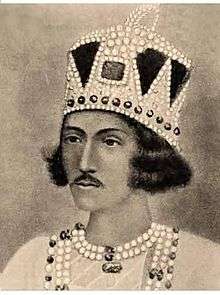 |
Mubarak ud-Daulah | Ashraf Ali Khan Bahadur | 1759 | 21 March 1770 – 6 September 1793 | 6 September 1793[78] |
 |
Azud ud-Daulah | Babar Ali Khan Bahadur | ? | 1793 – 28 April 1810 | 28 April 1810[79] |
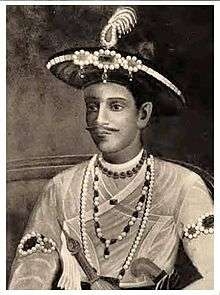 |
Ali Jah | Zain-ud-Din Ali Khan Bahadur | ? | 5 June 1810 – 6 August 1821 | 6 August 1821[80][81] |
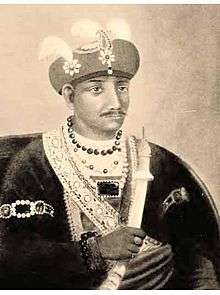 |
Walla Jah | Ahmad Ali Khan Bahadur | ? | 1821 – 30 October 1824 | 30 October 1824[82][83] |
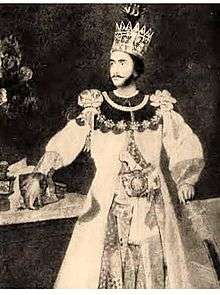 |
Humayun Jah | Mubarak Ali Khan Bahadur | 29 September 1810 | 1824 – 3 October 1838 | 3 October 1838[84][85][86] |
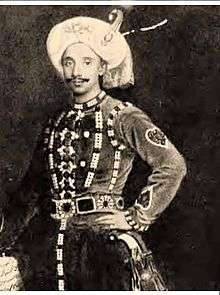 |
Feradun Jah | Syed Mansoor Ali Khan Bahadur | 29 October 1830 | 29 October 1838 – 1 November 1880 (abdicated) | 5 November 1884[87] |
List of the Nawabs of Murshidabad
The Nawabs of Murshidabad succeeded the Nawabs of Bengal after the abdication in 1881 and the abolition of the title of Nawab of Bengal in 1880.[27][38] There have been four Nawabs of Murshidabad ,as of 2014, as follows:
| Picture | Titular Name | Personal Name | Birth | Reign | Death |
|---|---|---|---|---|---|
| Najafi Dynasty | |||||
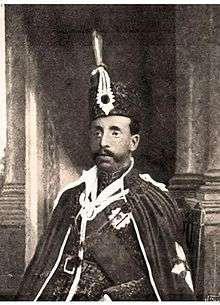 |
Ali Kadir | Syed Hassan Ali Mirza Khan Bahadur | 25 August 1846 | 17 February 1882 – 25 December 1906 | 25 December 1906[88][89] |
 |
Amir ul-Omrah | Syed Wasif Ali Mirza Khan Bahadur | 7 January 1875 | December 1906 – 23 October 1959 | 23 October 1959[90][91] |
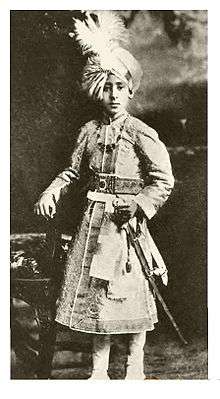 |
Raes ud-Daulah | Syed Waris Ali Mirza Khan Bahadur | 14 November 1901 | 1959 – 20 November 1969 | 20 November 1969[92] |
| N/A | N/A | Disputed/In abeyance[9][58] | N/A | 20 November 1969 – 13 August 2014 | N/A |
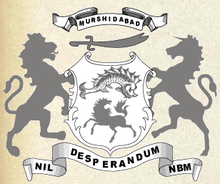 |
N/A | Syed Mohammed Abbas Ali Mirza Khan Bahadur | Circa 1942 | 13 August 2014 – Present[9][58] | Present |
Notes
- ↑ Imperial Gazetteer of India vol. IV 1907, p. 46
- ↑ Chaudhury, Sushil; Mohsin, KM (2012). "Sirajuddaula". In Islam, Sirajul; Jamal, Ahmed A. Banglapedia: National Encyclopedia of Bangladesh (Second ed.). Asiatic Society of Bangladesh.
- ↑ Singh, Vipul (2009). Longman History & Civics (Dual Government in Bengal). Pearson Education India. pp. 29–.
- ↑ Madhya Pradesh National Means-Cum-Merit Scholarship Exam (Warren Hasting's system of Dual Government). Upkar Prakashan. 2009. pp. 11–. ISBN 978-81-7482-744-9.
- 1 2 Murshidabad.net (8 May 2012). "Decline of the Nawabs of Bengal". Retrieved 10 August 2012.
- ↑ Murshidabad.net (8 May 2012). "Hassan Ali Mirza's succession". Retrieved 10 August 2012.
- 1 2 3 4 5 Lumby 1954, p. 232
- 1 2 "The last reigning Nawab of Murshidabad, Waris Ali Mirza Khan Bahadur". Retrieved 10 August 2012.
- 1 2 3 4 5 6 7 Mahato, Sukumar (20 August 2014). "Murshidabad gets a Nawab again, but fight for assets ahead". The Times of India. Retrieved 14 June 2015.
- ↑ Hasan, Perween (15 August 2007). Sultans and Mosques: The Early Muslim Architecture of Bangladesh. I.B.Tauris. p. 4. ISBN 9781845113810.
- ↑ Knight, Lisa I. (1 June 2011). Contradictory Lives: Baul Women in India and Bangladesh. Oxford University Press. p. 191. ISBN 9780199773619.
- ↑ Chakraborty, Mridula Nath (26 March 2014). Being Bengali: At Home and in the World. Routledge. p. 141. ISBN 9781317818908.
- ↑ Ray, Asok Kumar; Chakraborty, Satyabrata (2008). Society, Politics, and Development in North East India: Essays in Memory of Dr. Basudeb Datta Ray. Concept Publishing Company. p. 195. ISBN 9788180695728.
- 1 2 David Gilmour, The Ruling Caste: Imperial Lives in the Victorian Raj (2007) pp. 46, 135
- ↑ Sir James Bourdillon The Partition of Bengal (London: Society of Arts) 1905
- ↑ "History of Bangladesh". Bangladesh Student Association. Archived from the original on 19 December 2006. Retrieved 11 August 2012.
- ↑ "Britain Proposes Indian Partition". Regina, Saskatchewan, Canada: The Leader-Post. BUP. 2 June 1947.
- ↑ "Nawabs of Bengal were also known as Nawabs of Bengal, Bihar and Orissa". Murshidabad.nic.in. Retrieved 14 August 2012.
- ↑ "The Nawabs of Murshidabad ruled only over Murshidabad". Royal Ark. Retrieved 14 August 2012.
- ↑ Huq, Mohammad Daniul; Sarkar, Pabitra (2012). "Bangla Language". In Islam, Sirajul; Jamal, Ahmed A. Banglapedia: National Encyclopedia of Bangladesh (Second ed.). Asiatic Society of Bangladesh.
- ↑ Majumdar, R.C. (ed.) (2006). The Delhi Sultanate, Mumbai: Bharatiya Vidya Bhavan, p.197
- ↑ Majumdar, R.C. (ed.) (2006). The Delhi Sultanate, Mumbai: Bharatiya Vidya Bhavan, p.212
- ↑ Husain, ABM (2012). "Adina Mosque". In Islam, Sirajul; Jamal, Ahmed A. Banglapedia: National Encyclopedia of Bangladesh (Second ed.). Asiatic Society of Bangladesh.
- ↑ "Babu, the First Moghul Emperor: Wine and Tulips in Kabul". The Economist. 16 December 2010. pp. 80–82.
- ↑ "Sher Khan". Columbia Encyclopedia. 2010. Retrieved 24 August 2010.
- ↑ "Biography of Islam Shah the Successor of Sher Shah".
- 1 2 3 4 5 6 7 8 9 10 11 "The Nawabs ruled earlier under the Mughal and later under the British". Murdhidabad.net. 8 May 2012. Retrieved 9 August 2012.
- ↑ Ahmed, ABM Shamsuddin (2012). "Daud Khan Karrani". In Islam, Sirajul; Jamal, Ahmed A. Banglapedia: National Encyclopedia of Bangladesh (Second ed.). Asiatic Society of Bangladesh.
- ↑ The History of India: The Hindú and Mahometan Periods By Mountstuart Elphinstone, Edward Byles Cowell, Published by J. Murray, 1889,Public Domain
- ↑ Chatterjee, Anjali (2012). "Azim-us-Shan". In Islam, Sirajul; Jamal, Ahmed A. Banglapedia: National Encyclopedia of Bangladesh (Second ed.). Asiatic Society of Bangladesh.
- ↑ "Emergence of the Nawab of Bengal with Murshid Quli khan being the first Nawab". Murshidabad.net. Retrieved 17 August 2012.
- ↑ Mohsin, KM (2012). "Murshidabad". In Islam, Sirajul; Jamal, Ahmed A. Banglapedia: National Encyclopedia of Bangladesh (Second ed.). Asiatic Society of Bangladesh.
- ↑ Hist & Civics Viii Mat Board. Tata McGraw-Hill Education. 2005. p. 10. ISBN 9780070604452.
- ↑ Review Projector (India). T.R. Kesava Murthy. 1985. p. 31.
- ↑ Chaudhury, Sushil; Mohsin, KM (2012). "Sirajuddaula". In Islam, Sirajul; Jamal, Ahmed A. Banglapedia: National Encyclopedia of Bangladesh (Second ed.). Asiatic Society of Bangladesh.
- 1 2 Singh, Vipul (1 September 2009). Longman History & Civics (Dual Government in Bengal). Pearson Education India.
- 1 2 Madhya Pradesh National Means-Cum-Merit Scholarship Exam (Warren Hasting's system of Dual Government). Upkar Prakashan. 1 January 2009.
- 1 2 3 4 "Decline of the Nawabs of Bengal". Murshidabad.net. 8 May 2012. Retrieved 10 August 2012.
- ↑ Rahman, Urmi (23 December 2014). Bangladesh - Culture Smart!: The Essential Guide to Customs & Culture. Bravo Limited. ISBN 9781857336962.
- ↑ "Biography of Murshid Quli Khan". Murshidabad.net. 20 May 2012. Retrieved 9 August 2012.
- ↑ "Defeat of Sarfaraz Khan in the Battle of Giria". Murshidabad.net. 8 May 2012. Retrieved 9 August 2012.
- 1 2 3 4 "Defeat of Siraj ud-Daulah in the Battle of Plassey". Retrieved 28 July 2012.
- ↑ "Dynasties of The Nawabs". Murshidabad.net. 8 May 2012. Retrieved 9 August 2012.
- ↑ "Bengal subah was one the richest subahs of the Mughal Empire". Retrieved 17 August 2012.
- 1 2 History Modern India – S. N. Sen – Google Books. Books.google.co.in. Retrieved 6 July 2012.
- ↑ SNHM. Vol. II, pp. 209, 224.
- ↑ Wernham, R. B. (1 Nov 1968). The New Cambridge Modern History: Volume 3, Counter-Reformation and Price Revolution, 1559–1610 (Maratha invasion of Bengal). CUP Archive. Retrieved 14 August 2012.
- ↑ Sarkar, Jadunath (1 Jan 1991). Fall Of The Mughal Empire- Vol. I (4Th Edn.) (Maratha Chauth from Bihar). Orient Blackswan. Retrieved 14 August 2012.
- ↑ George Michell and Mark Zebrowski (10 Jun 1999). Architecture and Art of the Deccan Sultanates, Volumes 1-7 (Maratha raids in Bihar). Cambridge University Press. Retrieved 14 August 2012.
- ↑ "Incidents during Mubarak ud-Daulah's reign". Murshidabad.net. 8 May 2012. Retrieved 9 August 2012.
- 1 2 "Decline of the Nawabs of Bengal". Murshidabad.net. 8 May 2012. Retrieved 9 August 2012.
- ↑ "Hassan Ali Meerza's succession". Murshidabad.net. 8 May 2012. Retrieved 10 August 2012.
- ↑ "The Nawabs of Murshidabad had little or no say". Royal Ark. Retrieved 17 August 2012.
- ↑ Prakash, Ved (2008). Terrorism in India's North-east: A Gathering Storm. Gyan Publishing House. p. 350. ISBN 9788178356617.
- ↑ "Nawabs' Murshidabad House lies in tatters". The Times of India. Retrieved 2 May 2016.
- ↑ "Article 18 of Indian Constitution and Abolition of Titles". GK Today. Retrieved 18 June 2015.
- ↑ "Decline of the Nawabs of Murshidabad". Murshidabad.net. 24 May 2012. Retrieved 9 August 2012.
- 1 2 3 4 "Portrait of an accidental Nawab". The Times of India. 22 August 2014. Retrieved 14 June 2015.
- ↑ "The last Nawab of Murshidabad, Waris Ali Meerza Khan Bahadur". Retrieved 10 August 2012.
- 1 2 "The Nawabs of Bengal (chronologically)". Archived from the original on 6 January 2012. Retrieved 28 July 2012.
- ↑ Paul, Gautam. "Murshidabad History - Murshid Quli Khan". murshidabad.net. Retrieved 7 May 2016.
- ↑ "Murshid Quli Khan | Indian nawab". Encyclopedia Britannica. Retrieved 7 May 2016.
- ↑ Karim, Abdul (2012). "Murshid Quli Khan". In Islam, Sirajul; Jamal, Ahmed A. Banglapedia: National Encyclopedia of Bangladesh (Second ed.). Asiatic Society of Bangladesh.
- 1 2 Paul, Gautam. "Murshidabad History - Sarfaraz Khan". murshidabad.net. Retrieved 7 May 2016.
- ↑ Karim, KM (2012). "Shujauddin Muhammad Khan". In Islam, Sirajul; Jamal, Ahmed A. Banglapedia: National Encyclopedia of Bangladesh (Second ed.). Asiatic Society of Bangladesh.
- ↑ Paul, Gautam. "Murshidabad History - Suja-ud-Daulla". murshidabad.net. Retrieved 7 May 2016.
- ↑ Paul, Gautam. "Murshidabad History - Alivardi Khan". murshidabad.net. Retrieved 7 May 2016.
- ↑ Bengal, Past & Present: Journal of the Calcutta Historical Society. The Society. 1962. pp. 34–36.
- ↑ Paul, Gautam. "Murshidabad History - Siraj-ud-Daulla". murshidabad.net. Retrieved 7 May 2016.
- ↑ "Nawab Siraj-ud-Daulah". Story Of Pakistan. 3 January 2005. Retrieved 7 May 2016.
- ↑ Zaidpūrī), Ghulām Ḥusain (called Salīm (1902). The Riyaz̤u-s-salāt̤īn: A History of Bengal. Asiatic Society. p. 384.
- ↑ Paul, Gautam. "Murshidabad History - Mir Muhammed Jafar Ali Khan". murshidabad.net. Retrieved 7 May 2016.
- ↑ "Portrait of an accidental Nawab". The Times of India. Retrieved 7 May 2016.
- 1 2 Shah, Mohammad (2012). "Mir Jafar Ali Khan". In Islam, Sirajul; Jamal, Ahmed A. Banglapedia: National Encyclopedia of Bangladesh (Second ed.). Asiatic Society of Bangladesh.
- ↑ Bibliotheca Indica. Baptist Mission Press. 1902. p. 397.
- ↑ Paul, Gautam. "Murshidabad History - Najam-ud-Daulla". murshidabad.net. Retrieved 16 May 2016.
- ↑ Paul, Gautam. "Murshidabad History - Saif-ud-Daulla". murshidabad.net. Retrieved 16 May 2016.
- ↑ Khan, Abdul Majed (3 December 2007). The Transition in Bengal, 1756-75: A Study of Saiyid Muhammad Reza Khan. Cambridge University Press. ISBN 9780521049825.
- ↑ Paul, Gautam. "Murshidabad History - Babar Ali Delair Jang". murshidabad.net. Retrieved 2016-10-09.
- ↑ Paul, Gautam. "Murshidabad History - Ali Jah". murshidabad.net. Retrieved 2016-10-09.
- ↑ Majumdar, Purna Chundra (1905-01-01). The Musnud of Murshidabad (1704-1904): being a synopsis of the history of Murshidabad for the last two centuries, to which are appended notes of places and objects of interest at Murshidabad. Saroda Ray. p. 49.
- ↑ Paul, Gautam. "Murshidabad History - Wala Jah". murshidabad.net. Retrieved 2016-10-09.
- ↑ Indian Records: With a Commercial View of the Relations Between the British Government and the Nawabs Nazim of Bengal, Behar and Orissa. G. Bubb. 1870-01-01. p. 75.
- ↑ Paul, Gautam. "Murshidabad History - Humayun Jah". murshidabad.net. Retrieved 2016-10-09.
- ↑ Majumdar, Purna Chundra (1905-01-01). The Musnud of Murshidabad (1704-1904): being a synopsis of the history of Murshidabad for the last two centuries, to which are appended notes of places and objects of interest at Murshidabad. Saroda Ray. p. 50.
- ↑ Ray, Aniruddha (2016-09-13). Towns and Cities of Medieval India: A Brief Survey. Routledge. ISBN 9781351997300.
- ↑ Paul, Gautam. "Murshidabad History - Feradun Jah". murshidabad.net. Retrieved 2016-10-09.
- ↑ "MURSHID16". www.royalark.net. Retrieved 2016-10-09.
- ↑ Paul, Gautam. "Murshidabad History - Hassan Ali". murshidabad.net. Retrieved 2016-10-09.
- ↑ "MURSHID16". www.royalark.net. Retrieved 2016-10-09.
- ↑ Company, East India (1807-01-01). Papers Presented to the House of Commons Concerning the Late Nabob of the Carnatic. p. 118.
- ↑ Paul, Gautam. "Murshidabad History - Waresh Ali". murshidabad.net. Retrieved 2016-10-09.
External links
- The arrival of the Nawabs of Bengal and their decline
- Nawab Nizams of Bengal, Bihar and Orissa and Nawab Bahadurs of Murshidabad
- Posts under the Nawabs
_and_that_of_the_Nawab_of_Murshidabad_(bottom).png)